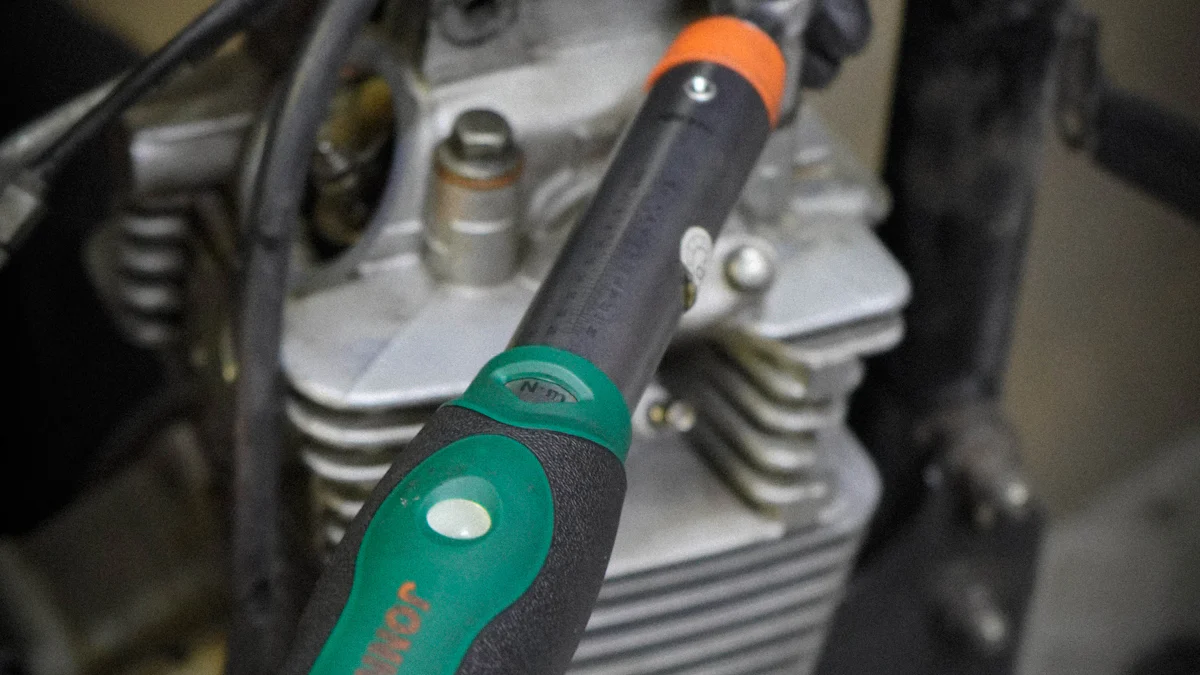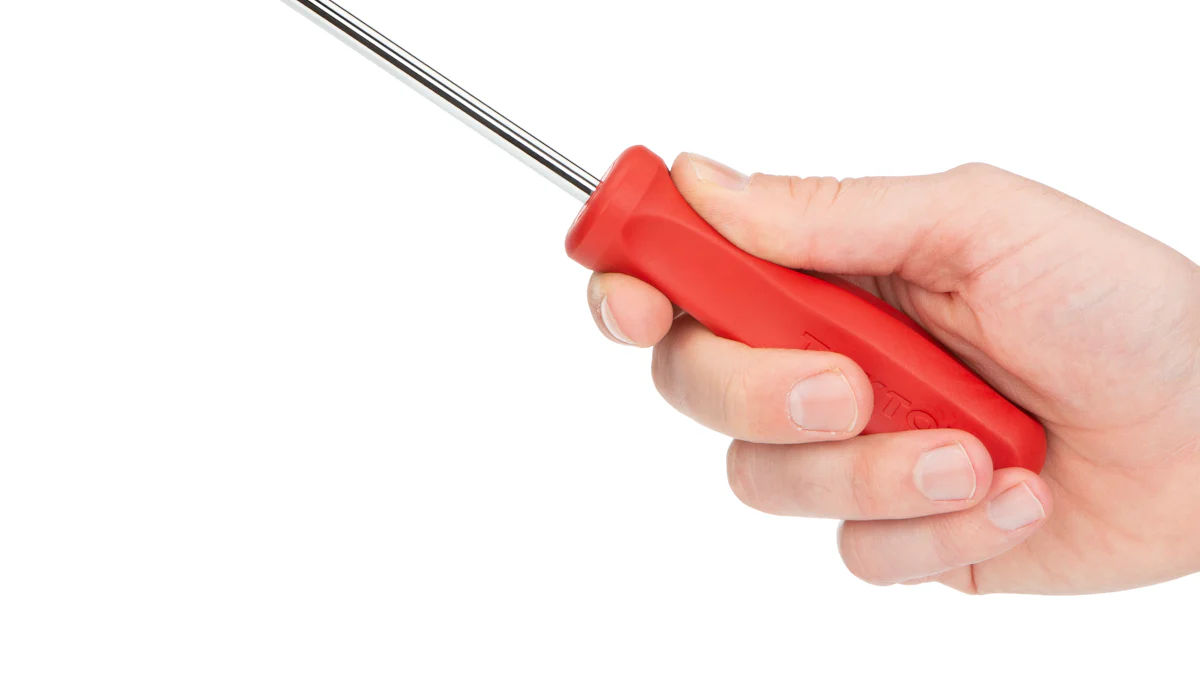
A digital torque screwdriver provides precise control over torque application, ensuring accurate and consistent results. Proper use of this tool is essential to prevent accidents and ensure safety. Incorrect torquing can lead to serious incidents, such as the crash of Emery Worldwide Flight 17 due to an improperly installed bolt. This blog aims to offer valuable tips for using a digital torque screwdriver safely, helping users achieve optimal performance while minimizing risks.
Understand the Digital Torque Screwdriver

Read the Manual
Importance of reading the manual
Reading the manual is crucial for understanding the proper use of a digital torque screwdriver. The manual provides detailed instructions on how to operate the tool safely and effectively. Ignoring the manual can lead to improper usage, which may result in inaccurate torque application or even accidents. The manual serves as a comprehensive guide, ensuring that users can maximize the tool’s potential while minimizing risks.
Key sections to focus on
Key sections in the manual include safety instructions, operating procedures, and maintenance guidelines. Safety instructions highlight the precautions necessary to avoid injury. Operating procedures explain how to set and adjust the torque settings accurately. Maintenance guidelines provide steps to keep the digital torque screwdriver in optimal condition. Focusing on these sections ensures that users can handle the tool with confidence and precision.
Familiarize Yourself with the Features
Overview of common features
A digital torque screwdriver comes with various features designed to enhance accuracy and usability. Common features include real-time torque measurement, peak mode, and programmable target values. Real-time measurement allows users to monitor torque application continuously. Peak mode captures the maximum torque applied during use. Programmable target values enable quick fastening with audible and visual indicators when the target is reached or exceeded.
How to use these features safely
Using these features safely involves understanding their functions and limitations. For example, real-time measurement helps in applying consistent torque, but users must ensure the tool remains steady. Peak mode is useful for recording maximum torque, but users should not rely solely on this feature for all applications. Programmable target values enhance efficiency, but users must preset accurate values to avoid over-tightening or under-tightening screws. Adhering to these guidelines ensures safe and effective use of the digital torque screwdriver.
Proper Calibration
Why Calibration is Crucial
Impact on accuracy
Calibration ensures that a digital torque screwdriver delivers precise torque measurements. Accurate torque application prevents over-tightening or under-tightening screws. This precision maintains the integrity of assemblies and avoids potential failures. Regular calibration verifies that the tool’s readings remain within acceptable tolerances. Consistent accuracy is essential for maintaining high-quality standards in various applications.
Safety implications
Proper calibration directly impacts safety. Misaligned torque readings can lead to improper fastening, which may result in equipment malfunction or structural failures. For example, an uncalibrated digital torque screwdriver could cause bolts to loosen over time, leading to hazardous conditions. Regular calibration minimizes these risks by ensuring that the tool operates correctly. This practice enhances user safety and protects the integrity of the work performed.
Steps to Calibrate
Tools needed
Calibrating a digital torque screwdriver requires specific tools. Essential items include a calibration device, a stable workbench, and the manufacturer’s manual. The calibration device should match the specifications of the screwdriver. A stable workbench provides a secure environment for accurate calibration. The manual offers detailed instructions tailored to the specific model of the screwdriver.
Step-by-step guide
- Prepare the Work Area: Ensure the workbench is clean and stable. Gather all necessary tools and the manual.
- Set Up the Calibration Device: Attach the calibration device to the workbench. Follow the manufacturer’s instructions for proper setup.
- Attach the Screwdriver: Secure the digital torque screwdriver to the calibration device. Ensure a firm connection to avoid slippage.
- Zero the Device: Reset the calibration device to zero. This step ensures that initial readings are accurate.
- Apply Torque: Gradually apply torque using the screwdriver. Monitor the readings on both the screwdriver and the calibration device.
- Compare Readings: Compare the readings from the screwdriver with those on the calibration device. Adjust the screwdriver settings if discrepancies exist.
- Record Results: Document the calibration results. Note any adjustments made to ensure future reference.
- Recheck: Repeat the process to confirm accuracy. Rechecking ensures that the calibration remains consistent.
Regular calibration and proper maintenance are critical for the effective use of a digital torque screwdriver. These practices ensure that the tool remains reliable and safe for various applications.
Use the Right Settings
Selecting the Correct Torque
Importance of correct torque settings
Selecting the correct torque setting is crucial for ensuring the integrity of assemblies. Incorrect torque can lead to over-tightening or under-tightening, which may damage components or compromise safety. A digital torque screwdriver provides precise control, allowing users to apply the exact amount of torque needed. Proper torque settings prevent equipment failure and extend the lifespan of fasteners.
How to determine the right setting
Determining the right torque setting involves understanding the specifications of the fasteners and materials involved. Consult the manufacturer’s guidelines for recommended torque values. Use a digital torque screwdriver to match the specified torque. The tool’s digital display helps in setting and monitoring the torque accurately. Always double-check the settings before starting any task to ensure precision.
Adjusting Settings Safely
Precautions to take
Adjusting the settings on a digital torque screwdriver requires careful attention. Ensure the tool is turned off before making any adjustments. Use the manual to understand the adjustment process. Avoid applying excessive force when changing settings. This precaution prevents damage to the tool and ensures accurate torque application.
Common mistakes to avoid
Common mistakes include setting the torque too high or too low. Over-tightening can strip threads or break fasteners. Under-tightening can lead to loose connections and potential failures. Another mistake is not recalibrating the tool after adjustments. Regular calibration ensures the digital torque screwdriver remains accurate. Always follow the manufacturer’s instructions to avoid these errors.
Maintain a Firm Grip

Proper Handling Techniques
How to hold the digital torque screwdriver
Holding a digital torque screwdriver correctly ensures accurate torque application and prevents accidents. Grasp the handle firmly with the dominant hand. Position the thumb along one side of the handle and wrap the fingers around the other side. This grip provides control and stability during use. Keep the wrist straight to avoid strain and maintain a steady hand.
Ensuring stability
Stability is crucial for precise torque application. Place the non-dominant hand near the workpiece to support the tool. This technique helps in maintaining balance and reducing tool slippage. Ensure the workpiece is securely clamped or held in place. A stable work environment minimizes errors and enhances safety.
Using Supportive Gear
Types of supportive gear
Supportive gear enhances the safety and efficiency of using a digital torque screwdriver. Common types include:
- Safety glasses: Protect the eyes from debris and accidental tool slips.
- Work gloves: Shield the hands from injuries and provide a better grip.
- Anti-fatigue mats: Reduce strain on the legs and back during prolonged use.
- Tool belts: Keep essential tools within easy reach, reducing the need for unnecessary movements.
Benefits of using them
Using supportive gear offers several benefits. Safety glasses prevent eye injuries from flying particles. Work gloves enhance grip and protect the hands from cuts and abrasions. Anti-fatigue mats improve comfort and reduce the risk of fatigue-related errors. Tool belts increase efficiency by keeping tools organized and accessible. Implementing these measures ensures a safer and more productive working environment.
Regular Maintenance
Cleaning the Tool
Cleaning materials needed
Maintaining a digital torque screwdriver requires specific cleaning materials. Essential items include a soft cloth, mild detergent, and a small brush. A soft cloth prevents scratches on the tool’s surface. Mild detergent effectively removes dirt and grime without causing damage. A small brush helps clean hard-to-reach areas.
Steps to clean properly
Proper cleaning ensures the longevity and performance of the tool. Follow these steps:
- Turn off the Tool: Ensure the digital torque screwdriver is powered off before cleaning.
- Wipe with a Soft Cloth: Use a soft cloth to remove loose dirt and dust from the tool’s surface.
- Apply Mild Detergent: Dampen the cloth with a solution of mild detergent and water. Gently wipe the tool to remove stubborn grime.
- Use a Small Brush: Employ a small brush to clean crevices and tight spots. This step ensures thorough cleaning.
- Dry the Tool: Wipe the tool with a dry cloth to remove any moisture. Ensure the tool is completely dry before storing or using it.
Regular cleaning keeps the digital torque screwdriver in optimal condition and prevents buildup that could affect performance.
Inspecting for Wear and Tear
Signs of wear and tear
Regular inspection helps identify signs of wear and tear. Look for the following indicators:
- Frayed Wires: Examine the power cord for any fraying or exposed wires.
- Loose Components: Check for any loose screws or parts that may affect functionality.
- Cracked Housing: Inspect the tool’s housing for cracks or damage.
- Inconsistent Readings: Monitor the tool for any irregularities in torque readings.
Identifying these signs early can prevent further damage and ensure the tool’s reliability.
When to replace parts
Replacing worn parts is crucial for maintaining the tool’s performance. Follow these guidelines:
- Frayed Wires: Replace the power cord immediately if fraying is detected.
- Loose Components: Tighten or replace any loose screws or parts.
- Cracked Housing: Replace the housing if cracks are found to maintain the tool’s integrity.
- Inconsistent Readings: Calibrate the tool regularly. Replace internal components if calibration does not resolve inconsistencies.
Regular maintenance and timely replacement of worn parts ensure the digital torque screwdriver remains accurate and safe for use.
Store Properly
Ideal Storage Conditions
Temperature and humidity considerations
Proper storage conditions ensure the longevity of a digital torque screwdriver. Store the tool in a cool, dry place to prevent damage. High temperatures can cause the internal components to degrade. Excessive humidity can lead to rust and corrosion. Maintain a stable environment to keep the tool in optimal condition.
Storage containers
Use appropriate storage containers to protect the digital torque screwdriver. Hard cases provide robust protection against physical damage. Soft cases offer a lightweight option for easy transport. Ensure the container has padding to cushion the tool. Secure the tool in the case to prevent movement during storage.
Avoiding Common Storage Mistakes
Mistakes to avoid
Avoid common mistakes to ensure proper storage. Do not leave the tool in direct sunlight. Exposure to UV rays can damage the tool’s exterior. Avoid placing the tool near sources of moisture. Water can seep into the tool and cause electrical issues. Do not store the tool with the battery inserted. Remove the battery to prevent leakage and corrosion.
Tips for better storage
Follow these tips for better storage practices. Label the storage container for easy identification. Keep the tool in its original packaging if possible. Original packaging provides the best fit and protection. Store the tool in an upright position to prevent pressure on sensitive components. Regularly inspect the storage area for signs of pests or mold. Clean the storage container periodically to maintain a dust-free environment.
Proper storage practices extend the life of a digital torque screwdriver. Adhering to these guidelines ensures the tool remains reliable and ready for use.
Use Protective Equipment
Types of Protective Gear
Gloves, goggles, etc.
Using protective gear ensures safety when operating a digital torque screwdriver. Essential items include gloves, goggles, and ear protection. Gloves protect hands from cuts and abrasions. Goggles shield eyes from flying debris. Ear protection reduces noise exposure during prolonged use.
How they enhance safety
Protective gear minimizes injury risks. Gloves provide a firm grip, reducing slippage. Goggles prevent eye injuries from particles. Ear protection safeguards hearing in noisy environments. Using these items enhances overall safety and efficiency.
Ensuring Proper Fit
How to choose the right size
Selecting the correct size for protective gear is crucial. Measure hands for glove size. Choose goggles that fit snugly without gaps. Select ear protection that covers ears completely. Proper sizing ensures comfort and effectiveness.
Importance of a proper fit
A proper fit maximizes protection. Ill-fitting gloves can hinder movement. Loose goggles may allow debris to enter. Inadequate ear protection fails to block noise effectively. Ensuring a proper fit enhances safety and performance.
Stay Focused and Alert
Avoiding Distractions
Common distractions
Distractions can compromise safety when using a digital torque screwdriver. Common distractions include background noise, mobile devices, and conversations with colleagues. Environmental factors like poor lighting or cluttered workspaces also divert attention. Identifying these distractions helps in creating a safer work environment.
Tips to stay focused
Staying focused requires proactive measures. Create a quiet workspace by minimizing background noise. Silence mobile devices to prevent interruptions. Use proper lighting to ensure visibility. Organize the workspace to reduce clutter. Take regular breaks to maintain mental alertness. Implementing these strategies enhances concentration and safety.
Recognizing Fatigue
Signs of fatigue
Fatigue poses significant risks during tool operation. Signs of fatigue include yawning, heavy eyelids, and frequent blinking. Reduced concentration and slower reaction times also indicate fatigue. Physical symptoms such as muscle aches and headaches may occur. Recognizing these signs is crucial for preventing accidents.
How to manage fatigue
Managing fatigue involves adopting healthy habits. Ensure adequate sleep to maintain energy levels. Stay hydrated and consume balanced meals. Take short breaks during prolonged tasks to rest and recharge. Perform light stretching exercises to alleviate muscle tension. Prioritize tasks to avoid overexertion. These practices help in maintaining alertness and ensuring safe tool operation.
Safety remains paramount when using digital torque screwdrivers. Users must adhere to best practices to prevent injuries and ensure accurate torque application. Key tips include reading the manual, calibrating regularly, selecting the correct settings, maintaining a firm grip, performing regular maintenance, storing properly, using protective equipment, and staying focused. Following these guidelines will enhance tool performance and longevity. Users should commit to these safety measures for optimal results and a secure working environment.
See Also
Scooter Upgrades: High-Quality Parts for Maximum Performance
Men and Women’s Sock Selection: A Diverse Range
